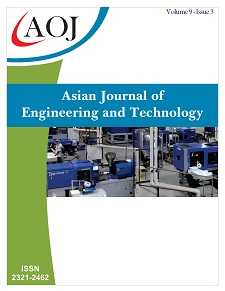A Combination between Synthetic Unit Hydrograph (SCS) and Rational Method in a similar Conditions Water Shed
DOI:
https://doi.org/10.24203/ajet.v9i3.6622Keywords:
Wadi Dahab, HEC-WMS software, DEM, IDF curves, hyfran-plus softwareAbstract
Studying watershed characteristics and choosing the most applicable methods to determine the amount of access rainfall that ran off is very important in many engineering applications, especially hydrology applications. That is to know the more suitable methods for protection against floods and to maximize benefits from the excess water. This study aims to establish a relation between the rational method and the SCS method. A subbasin in Wadi Dahab in Sinai, Egypt is investigated as a study area. To achieve the study aims, HEC-WMS software is chosen, which can analyze a watershed by using DEM and delineating basin. It calculates also important watershed parameters like area, runoff distances, and slope. The rainfall data is compiled and arranged. A statical analysis is executed to obtain the IDF curves. Hyfran-plus software is employed to locate the maximum depths for different return periods. Various values for the time of concentration are studied.
It is concluded that the difference between the rational and SCS methods is great for the time of concentration till 2 hours, then it decreases obviously from 2 till 6 hours. Also, it is concluded that the difference between the two methods is bigger for the small return periods of 2 and 5 years for all values of the time of concentration.
Employing the obtained equations, the peak runoff for one of the two methods (the rational and SCS methods) can be calculated knowing the time of concentration and the peak runoff for the second method.
References
Hodgkins, G.A., Hebson, Charles, Lombard, P.J., and Mann, Alexander, "Comparison of peak-flow estimation methods for small drainage basins in Maine": U.S. Geological Survey Scientific Investigations Report -5170, 32pp. 2007
Banasik, Kazimierz and Rutkowska, Agnieszka and Kohnová, Silvia ," Retention and Curve Number Variability in a Small Agricultural Catchment", The Probabilistic Approach.Open access journal Water:pp.1118 -1133, 2014
Peter J. Coombes, Mark Babister, and Tony McAlister ."Is the Science and Data underpinning the Rational Method Robust for use in Evolving Urban Catchments", Australia , 2015
R. Amutha. P. Porchelvan.'' Estimation of Surface Runoff in Malattar Sub-watershed using SCSCN Method". Journal Indian Soc. Remote Sens. No.37, pp.291–304, June 2009
A.Majidi, M. Moradi, H. Vagharfard, A. purjenaie." Evaluation of Synthetic Unit Hydrograph (SCS) and Rational Methods in Peak Flow Estimation (Case Study: Khoshehaye Zarrin Watershed, Iran)", International Journal of Hydraulic Engineering., Vol 1, No5, pp.43-47,2012
Maria Prama, Adel Omran, Dietrich Schröder, and Abdou Abouelmagd “Vulnerability assessment of fash foods in Wadi Dahab Basin, Egypt”. Environmental Earth Sciences ,pp.79:114 ,2020
Sara M. Abuzied and Basma M. H. Mansou. "Geospatial hazard modeling for the delineation of
flash flood-prone zones in Wadi Dahab basin, Egypt", Journal of Hydroinformatics",No.043.2018
Abuzied, S. M., and Pradhan. "Hydro-geomorphic assessment of erosion intensity and sediment yield initiated debris-flow hazards at Wadi Dahab Watershed, Egypt". Journal of Georisk: Assessment and Management of Risk for Engineered Systems and Geohazards,pp. 1-26, 2020
Ahmed A. Dakheel "Drawing Curves of The Rainfall Intensity Duration Frequency (IDF)and Assessment equation Intensity Rainfall for Nasiriyah City, Iraq", Journal of Thi-Qar University, Vol. 12 NO.2,pp. 63-87, 2018
Downloads
Published
Issue
Section
License
Copyright (c) 2021 Mona Fathi, Neveen B. Abelmageed, M. Hassan

This work is licensed under a Creative Commons Attribution-NonCommercial 4.0 International License.
- Papers must be submitted on the understanding that they have not been published elsewhere (except in the form of an abstract or as part of a published lecture, review, or thesis) and are not currently under consideration by another journal published by any other publisher.
- It is also the authors responsibility to ensure that the articles emanating from a particular source are submitted with the necessary approval.
- The authors warrant that the paper is original and that he/she is the author of the paper, except for material that is clearly identified as to its original source, with permission notices from the copyright owners where required.
- The authors ensure that all the references carefully and they are accurate in the text as well as in the list of references (and vice versa).
- Authors retain copyright and grant the journal right of first publication with the work simultaneously licensed under a Attribution-NonCommercial 4.0 International that allows others to share the work with an acknowledgement of the work's authorship and initial publication in this journal.
- Authors are able to enter into separate, additional contractual arrangements for the non-exclusive distribution of the journal's published version of the work (e.g., post it to an institutional repository or publish it in a book), with an acknowledgement of its initial publication in this journal.
- Authors are permitted and encouraged to post their work online (e.g., in institutional repositories or on their website) prior to and during the submission process, as it can lead to productive exchanges, as well as earlier and greater citation of published work (See The Effect of Open Access).
- The journal/publisher is not responsible for subsequent uses of the work. It is the author's responsibility to bring an infringement action if so desired by the author.


